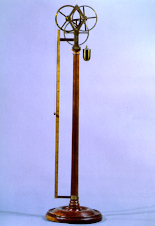
80.7 x 22 (diameter)
Brass and wood
CAT. 1824 : D.IV.40
Um apparelho, que consta de tres rodas, duas das quaes são dentadas, e tem seus carretes para se poder mover todo o systema. Tem de diametro tres poll. e 9 linhas cada uma: proxima a ellas em direcção vertical está uma regoa dividida em 80 partes ao longo da qual desce um pezo, que é 80 vezes menor, que outro, que o contrabalança, o qual se move ao longo d'uma pequena regoa de marfim, que tem marcado um espaço igual a 1/80 da outra regoa. Serve para mostrar, que nos systemas de rodas dentadas a potencia está para a resistencia, como o producto do eixo, onde se envolve a corda pelos diametros dos carretos, para o producto dos diametros de todas as rodas.
An apparatus consisting of three wheels, two with cogs and pinions for setting the apparatus in motion; each is three inches and 9 lines in diameter. Above them is a guage divided into 80 parts, down which a weight passes; this weight is 80 times less than the one counterbalancing it. The counterbalance weight moves along a small ivory guage marking a length 1/80th that of the first guage. It demonstrates that in cogwheel systems the power is to the resistance as the product of the axle, bearing the rope which goes round the diameters of the cogwheels, is to the product of the diameters of all the wheels.
The mechanism, part of the Gabinete de Física's collection of instruments used in teaching, consists of a series of three geared cogwheels. Two objects are suspended from the outer wheels, one of them eighty times heavier than the other.
This instrument was built in Lisbon in 1805 by Jacob Bernard Haas. In addition to showing the multiplying effect of forces through assemblies of cogwheels, it was useful in comparing the distances travelled by two bodies suspended in the system, when the wheels were made to rotate. The ratio between these distances is 1 to 80: that is, the distance travelled by the lighter body is eighty times greater than that travelled by the heavier.
Sigaud de La Fond, Joseph-Aignan, Description et Usage d'un Cabinet de Physique Expérimentale, Leiden, 1775, Vol. I, Pl. XVI,
Fig. 7.
Musschenbroek, Peter van, Introductio ad Philosophiam Naturalem, Leiden, 1762, Vol.I, Tab. VII, Fig.5.